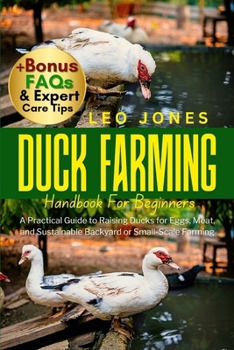Duck Farming Handbook for Beginners: A Practical Guide to Raising Ducks for Eggs, Meat, and Sustainable Backyard or Small-Scale Farming
Importance of Ducks in Agriculture
Ducks play a crucial role in integrated farming systems. They are highly adaptable birds that thrive in diverse environments, making them suitable for both small-scale backyard setups and large-scale commercial operations. Ducks contribute significantly to pest control, especially in rice paddies where they feed on insects, weeds, and larvae, reducing the need for chemical pesticides. Additionally, their manure is rich in nitrogen, phosphorus, and potassium, making it a valuable organic fertilizer for crops and fish ponds in integrated farming systems. Ducks are also easier to manage compared to some other poultry species. They are hardy animals that can withstand a variety of weather conditions and have fewer disease problems, making them ideal for beginner farmers. Their ability to forage naturally reduces feed costs and increases farm sustainability. Economic and Nutritional Value From an economic perspective, duck farming offers multiple income streams: Egg production: Certain breeds like Khaki Campbell and Indian Runner can lay 250-300 eggs per year.
Meat production: Meat breeds such as Pekin ducks are highly valued for their fast growth rate and tender meat.
Feathers and down: Duck feathers are used in bedding and clothing products, providing an additional byproduct for income. Ducks also mature faster than chickens in some cases, making them a quick-return investment. Their products (meat and eggs) often fetch higher market prices due to their rich flavor and nutritional profile. Nutritionally, duck meat is high in protein, iron, and essential B vitamins. Duck eggs contain more fat and cholesterol than chicken eggs, but they are also richer in omega-3 fatty acids and vitamin D, making them appealing to certain health-conscious consumers and specialty markets. Brief History and Domestication of Ducks Ducks have been domesticated for thousands of years. Historical records show that ducks were first domesticated in Southeast Asia and China over 4,000 years ago. Early civilizations recognized their value in food production and integrated them into their agricultural systems. Over time, selective breeding led to the development of various breeds adapted to local environments and purposes, such as meat, eggs, or ornamental use. In Europe and North America, duck farming expanded significantly during the 19th and 20th centuries with the establishment of commercial operations and breed standardization.
Ducks play a crucial role in integrated farming systems. They are highly adaptable birds that thrive in diverse environments, making them suitable for both small-scale backyard setups and large-scale commercial operations. Ducks contribute significantly to pest control, especially in rice paddies where they feed on insects, weeds, and larvae, reducing the need for chemical pesticides. Additionally, their manure is rich in nitrogen, phosphorus, and potassium, making it a valuable organic fertilizer for crops and fish ponds in integrated farming systems. Ducks are also easier to manage compared to some other poultry species. They are hardy animals that can withstand a variety of weather conditions and have fewer disease problems, making them ideal for beginner farmers. Their ability to forage naturally reduces feed costs and increases farm sustainability. Economic and Nutritional Value From an economic perspective, duck farming offers multiple income streams: Egg production: Certain breeds like Khaki Campbell and Indian Runner can lay 250-300 eggs per year.
Meat production: Meat breeds such as Pekin ducks are highly valued for their fast growth rate and tender meat.
Feathers and down: Duck feathers are used in bedding and clothing products, providing an additional byproduct for income. Ducks also mature faster than chickens in some cases, making them a quick-return investment. Their products (meat and eggs) often fetch higher market prices due to their rich flavor and nutritional profile. Nutritionally, duck meat is high in protein, iron, and essential B vitamins. Duck eggs contain more fat and cholesterol than chicken eggs, but they are also richer in omega-3 fatty acids and vitamin D, making them appealing to certain health-conscious consumers and specialty markets. Brief History and Domestication of Ducks Ducks have been domesticated for thousands of years. Historical records show that ducks were first domesticated in Southeast Asia and China over 4,000 years ago. Early civilizations recognized their value in food production and integrated them into their agricultural systems. Over time, selective breeding led to the development of various breeds adapted to local environments and purposes, such as meat, eggs, or ornamental use. In Europe and North America, duck farming expanded significantly during the 19th and 20th centuries with the establishment of commercial operations and breed standardization.
Format:Paperback
Language:English
ISBN:B0FP15N4QG
ISBN13:9798262220489
Release Date:August 2025
Publisher:Independently Published
Length:136 Pages
Weight:0.42 lbs.
Dimensions:0.3" x 6.0" x 9.0"
Customer Reviews
0 rating





